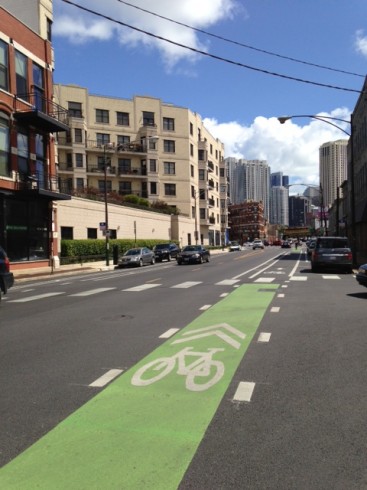I have submitted the comments below to Forbes Magazine, whose blog posted an article titled “Spotted Those New Protected Bike Lanes? Get Ready for More.”
I expected better of Forbes, a generally conservative publication. The term “protected bike lane” is used only to describe an on-street bikeway behind a barrier, but Forbes illustrated the article with a photo of a buffered bike lane. There is no barrier in the photo, only paint.
My comments follow.
************
A few clarifications:
* The bike lane shown in the photo is not a “protected bike lane”. A “protected bike lane” (see below for why I use the quotes) is separated from the rest of the travelway by a barrier, which could be a curbed median island, a row of parked cars, or a row of delineator posts. What is shown is a buffered bike lane, separated from another lane by a painted strip which is wider than the standard lane stripe.
* This buffered bike lane is separated from the adjacent travel lane, but adjacent to a parking lane, and directs bicyclists to ride within the range of opening car doors. A bicyclist who strikes an opening car door is flung to the left, potentially going under the wheels of an overtaking motor vehicle.
* A buffer may on the other hand separate the bike lane from the parking lane. This is safer.
* The inaccurate term “protected bike lane” is used with the goal of promoting increased bicycle use, pandering to widespread misconceptions about safety, and in particular, the belief that the most important type of bicycle crash is for a bicyclist to be rear-ended by a motor vehicle. This type of crash is rare in urban areas.
* The term “protected bike lane” is incorrect and misleading. Being separated by a barrier, this is not a lane, it is a bicycle path. Also, it is protected everywhere except where that matters most: at intersections and driveways, where most motor-vehicle-bicycle collisions occur, and conflicting movements forced by the barrier (car turning right from left lane, bicyclist in right rear blindspot of motor vehicle, or concealed by parked vehicles) increase the risk.
* Typical safe average speeds on “protected bike lanes” are 5 miles per hour, increasing the temptation to take risks and disobey the law.
* In some cases it is possible to have a separate bikeway in a street corridor which avoids the problems, but this is unusual and requires careful designs. One example is with 9th Avenue in New York City; please see comments linked at http://john-s-allen.com/galleries/NYC (and for a counterexample, see the comments on the Grand Street bikeway linked from the same page.)
* Other options such as conventional bike lanes of adequate design, paths separate from roads, bicycle routes on lightly-traveled streets paralleling main streets, traffic speed reduction measures, enforcement and education avoid the problems with barrier-separated bikeways. However, barrier-separated bikeways are being heavily promoted and widely installed, because of the public misconceptions about safety and the clamor of bicycle mode share advocacy.
I am a long-time bicycling advocate and it pains me to see the state of bicycling advocacy today; also, the shallowness of media coverage, and yes, this article is an example. If Forbes can’t even get terminology right and call out inaccuracies and distortions, it is only contributing to the problem.


I see the comments have not appeared yet. Yes, that is a pretty shallow article.
Looks like it’s there now.
The third word of their article has a typo. That doesn’t bode well for the quality of the rest of the article. Does anyone like in a big Canadian city?
Interestingly, Forbes seems to have pulled the article down now: http://www.forbes.com/sites/michelinemaynard/2013/09/02/spotted-those-new-protected-bike-lanes-get-ready-for-more/ and searches on the site lead to a “cannot find it” page.
Thanks for your comments, John.
I was curious about Forbes having allegedly taken down this article and found it fairly easily after clicking the above link provided by Jeff. Here’s a direct link to it: http://tinyurl.com/lh5zmpx.
I note it’s written by Micky Maynard who has appeared frequently on the PBS News Hour. She doesn’t seem to be a knowledgeable cyclist but that doesn’t stop anyone writing about the subject!
Martin — Thanks for the link. Yes, it works.
It’s marketing confusion, of course. http://www.peopleforbikes.org/blog/entry/selling-biking-better-language-for-better-bike-lanes Green Lane Project itself can’t really pin down what to call facilities–“cycle track” used to be so very fashionable, but now the marketing angle seems to be that “protected” (and using the word is essentially lying in most cases of installed facilities) needs to be part of the name.